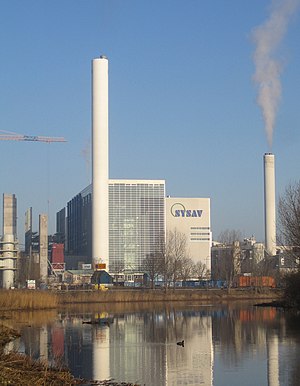Such incinerators are making progress in the U.S. but critics remain
From the sidewalk there’s almost no evidence that behind the walls of the energy-from-waste plant in Alexandria, Va., an incinerator is burning garbage at more than 1,700 degrees Fahrenheit and providing electricity to thousands of homes.
“Everything that the resident puts out on the street in a trash can comes here,” said Bryan Donnelly, the facility manager. At his location, that amounts to about 350,000 tons of municipal waste per year.
The plant, built in 1988, processes garbage from all of Alexandria and Arlington, Va., and some parts of the District of Columbia and Maryland. Heat from the high-temperature incineration of waste, which company representatives call a “clean burn,” runs a generator that puts 23 megawatts of electricity back on the grid — enough to power 20,000 homes.
The facility is owned and operated by Covanta Energy Corp., one of the leaders in converting solid waste into energy, with 41 plants in North America. On average, the company produces 550 to 750 kilowatt-hours of electricity per ton of waste, said Chief Sustainability Officer Paul Gilman. While the power comes from burning garbage, there’s a big difference between a traditional incinerator and what Covanta does, he said — “we’re a power plant.”
“We have the same waste hierarchy as the E.U.: reduce, reuse, recycle, energy recovery and disposal,” said Gilman. “[This] is that step we call the ‘fourth R.’ After you reduce, reuse and recycle that, you take the step of energy recovery before you put it in the ground.”
To make sure the energy is generated cleanly, Covanta says, there are a number of high-tech pollution controls in place. That includes a baghouse to capture particulate matter (such as mercury), carbon injections to absorb heavy metals, dioxins and furans, and the addition of lime to neutralize acid gases. Computer systems closely monitor pollutant levels to make sure they remain as low as possible.
But some communities and environmentalists question whether those measures are enough, while waste-to-energy facilities are rejected in places where it is still more economical to send waste to landfills. There are also concerns over harmful greenhouse gas emissions, the sustainability of energy recovery plants and whether or not they inhibit recycling efforts.
Many of these worries were expressed in public comment submissions last week in response to Covanta’s petition to have energy from waste included in the main tier of New York state’s renewable portfolio standard (RPS). Opponents say labeling waste as a renewable energy source will take dollars away from projects like wind and solar. Some claim the action also detracts from the larger issue — that there needs to be more recycling and less waste to begin with.
How to turn trash into energy and offset emissions
There are currently 86 waste-to-energy facilities in the United States. According to the Energy Recovery Council, they provide 2,700 MW of clean electricity on a 24-hour-per-day, 365-day-per-year basis — enough to power about 2 million homes.
In Europe there are more than 400 of these facilities. Another 300 facilities, many of which are in China and Japan, are located around the world, in 40 countries in total.
The way the system works is this: A dump truck drops the municipal waste into a warehouse-sized pit. Then a giant claw (much like one that picks up loot in an arcade game) grabs nearly a truckload of garbage and dumps it into an incinerator.
Technology developed in Europe mixes the waste at temperatures of up to 2,000 degrees Fahrenheit. The heat then makes steam, which runs a turbine and produces electricity.
Metals are separated. Covanta claims to recycle 400,000 tons of metal per year. Leftover ash, now a cement-like product, is carted off to line landfills.








